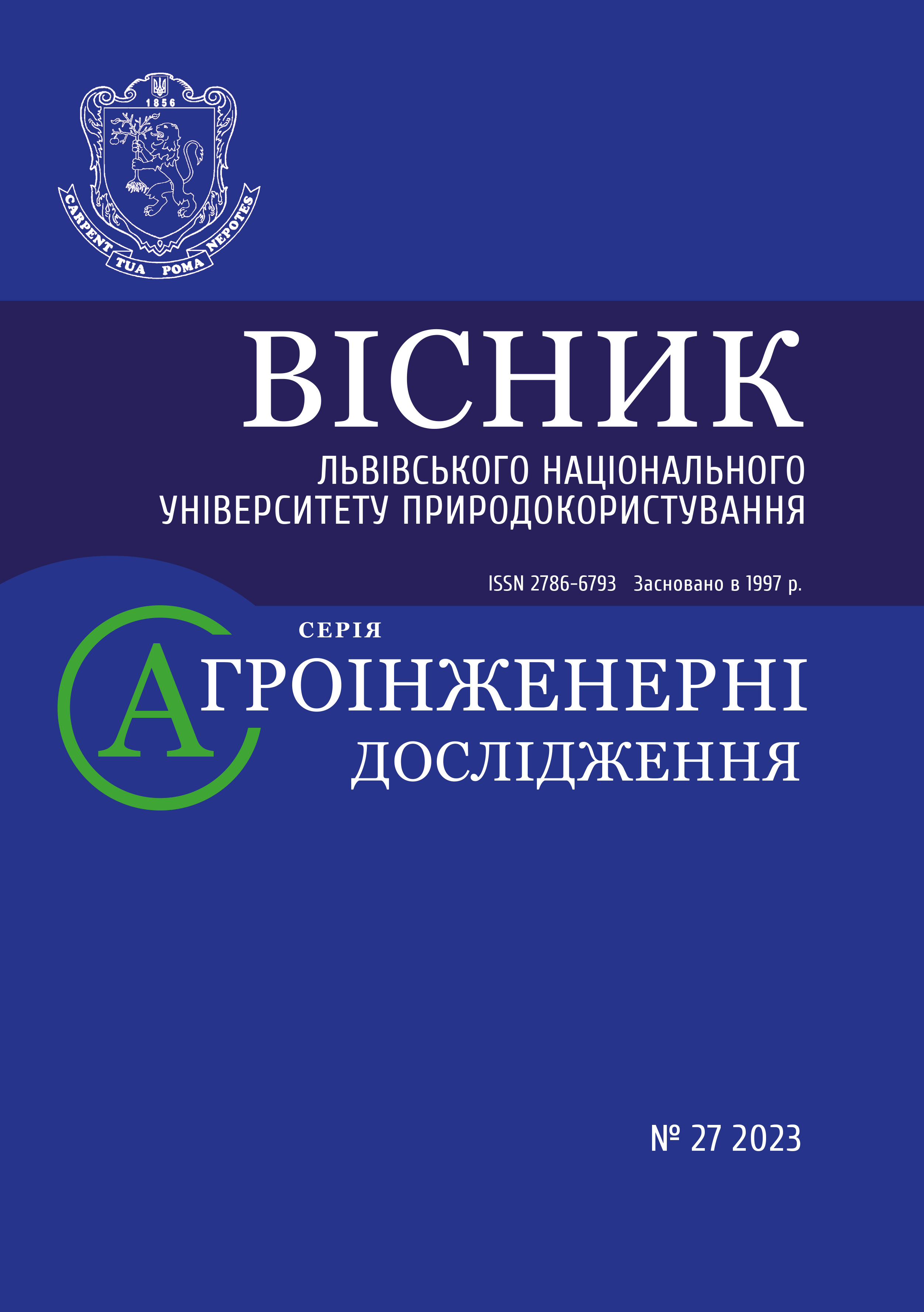Аналіз сучасних датчиків та обґрунтування доцільності автоматизованого моніторингу споживання корму свинями у фермерських господарствах
DOI:
https://doi.org/10.31734/agroengineering2023.27.043Ключові слова:
моніторинг, автоматизовані процеси, споживання кормів, датчикиАнотація
Виконано аналіз процесу автоматизованого моніторингу споживання кормів свинями в різних фермах. Встановлено особливості процесу споживання корму, які лежать в основі ефективного управління годівлею та оптимального росту тварин. Виконано аналіз сучасних датчиків для автоматизованого моніторингу споживання кормів свинями та обґрунтовано доцільність їх використання. Встановлено основні типи датчиків, які автори пропонують застосувати для автоматизованого моніторингу. До них належать датчики ваги, руху, об'єму та для відслідковування індивідуального споживання корму. На підставі проведеного аналізу встановлено, що для моніторингу споживання корму за допомогою датчиків руху перевагу надають використанню методології аналізу зображень. Для моніторингу індивідуального споживання свинями корму рекомендують використати технологію радіочастотної ідентифікації (RFID), яка використовує радіохвилі для зчитування та захоплення інформації, що зберігається на мітці, прикріпленій до об’єкта. Кожен з окремих видів цих датчиків має свої переваги та недоліки за показниками точності, надійності, вартості та простоти встановлення. Встановлено, що, незважаючи на недоліки існуючих датчиків для автоматизованого моніторингу споживання корму свинями, вони мають значні переваги перед ручним моніторингом годівлі, включаючи збір даних у режимі реального часу, підвищену точність і зниження витрат на робочу силу. Означено задачі, які слід розв’язувати під час автоматизованого моніторингу кормів. Вирішення основних із них дає змогу підвищити точність збору даних та, відповідно, ефективність годування тварин. Встановлено, що автоматизований моніторинг споживання кормів із використанням сучасних датчиків має великий потенціал для підвищення ефективності та рентабельності свинарства. Вибір датчиків для автоматизованих систем моніторингу споживання кормів значною мірою впливає на ефективність та надійність систем і є напрямом подальших досліджень.
Посилання
Ahmed, S., Mun, H., Yoe, H., & Yang, C. (2015). Monitoring of behavior using a video-recording system for recognition of Salmonella infection in experimentally infected growing pigs. Animal, 9, 115-121.
Bekraoui, A., & Hadjadj, A. (2020). Thermal flow sensor used for thermal mass flowmeter. Microelectronics Journal, 103, 104871. doi: 10.1016/j.mejo.2020.104871.
Hryshchuk, O. V. (2021). Automated systems of control and management of pig feeding by applying modern technologies. Technology, energy, transport APK, 3, 16-19.
Kashiha, M. A., Bahr, C., Ott, S., Moons, C. P. H., Niewold, T. A., Tuyttens, F., & Berckmans, D. (2014). Automatic monitoring of pig locomotion using image analysis. Livestock Science. 159, 141–148.
Kashiha, M., Bahr, C., Haredasht, S. A., Ott, S., Moons, C. P., Niewold, T. A., Ödberg, F. O., & Berckmans, D. (2013). The automatic monitoring of pigs water use by cameras. Computers and Electronics in Agriculture. 90, 164–169.
Kovaliova, O. V. (2020). Development of the technologies of pig feeding by applying automatic systems of control for their feeding. Agrarian bulletin Black sea region, 4, 92-97.
Lao, F., Brown-Brandi, T., Stinn, J. P., Liu, K., Teng, G., & Xin, H. (2016). Automatic recognition of lactating sow behaviors through depth image processing. Computers and Electronics in Agriculture, 125, 56–62.
Li, D., Chen, Y., Zhang, K., & Li, Z. (2019). Mounting Behaviour Recognition for Pigs Based on Deep Learning. Sensors, 19, 4924.
Li, K., & Slattery, C. (2014). Electromagnetic Flow Meters Achieve High Accuracy in Industrial Applications. Analog Dialogue, 48-02.
Nasirahmadi, A., Edwards, S. A., & Sturm, B. (2017). Implementation of machine vision for detecting behaviour of cattle and pigs. Livestock Science, 202, 25-38.
Nasirahmadi, A., Hensel, O., Edwards, S. A., & Sturm, B. (2016). Automatic detection of mounting behaviours among pigs using image analysis. Computers and Electronics in Agriculture, 124, 295-302.
Nasirahmadi, A., Sturm, B., Edwards, S., Jeppsson, K.-H., Olsson, A.-C., Müller, S., & Hensel, O. (2019). Deep Learning and Machine Vision Approaches for Posture Detection of Individual Pigs. Sensors, 19, 37-38.
Rui, Ren, Hongliang, Wang, Xiaolei, Sun, & He, Quan. (2022). Design and Implementation of an Ultrasonic Flowmeter Based on the Cross-Correlation Method. Sensors, 22(19), 7470. doi: 10.3390/s22197470.
Savchenko, O. O., Kolomiiets, Yu. V., & Hlushchenko, O. V. (2019). Development of pig-raising technology in conditions of production process automation. Bulletin of Petro Vasylenko Kharkiv National Technical University of Agriculture. Series: Mechanization of agro-industrial production, 199, 166-173.
Shumylo, I. M., Parkhomenko, O. O., & Moroz, L. V. (2021). Automation of the technology of pig feeding by applying modern information technologies. Scientific bulletin of Polissia, 2 (16), 200-208.
Tkachuk, S. V., & Kozachenko, A. A. (2018). Automated systems of control for pig feeding parameters. Machinery and technology of food production, 4 (14), 1-7.
Tryhuba, A. M., & Sydorchuk, O. V. (2010). Peculiarities of planning the projects and programs of agrarian production. Project management: conditions and prospects: Proceedings of the 6th International conference, 313-316). Mykolaiv: NUK.
Tryhuba, A., & Bashynsky, O. (2019). Coordination of dairy workshops projects on the community territory and their project environment, International Scientific and Technical Conference on Computer Sciences and Information Technologies, 3, 51–54.
Tryhuba, A., Boyarchuk, V., Tryhuba, I., Ftoma, O., Francik, S., & Rudynets, M. (2020). Method and Software of Planning of the Substantial Risks in the Projects of Production of raw Material for Biofuel. CEUR Workshop Proceedings, 2565, 116-129.
Tryhuba, A., Tryhuba, I., Ftoma, O., & Boyarchuk, O. (2019). Method of quantitative evaluation of the risk of benefits for investors of fodder-producing cooperatives. 14th International Scientific and Technical Conference on Computer Sciences and Information Technologies (CSIT), 3, 55–58.
Yang, A., Huang, H., Zhu, X., Yang, X., Chen, P., Li, S., & Xue, Y. (2018). Automatic recognition of sow nursing behaviour using deep learning-based segmentation and spatial and temporal features. Biosystems Engineering, 175, 133–145.
Zheng, C., Zhu, X., Yang, X., Wang, L., Tu, S., & Xue, Y. (2018). Automatic recognition of lactating sow postures from depth images by deep learning detector. Computers and Electronics in Agriculture, 147, 51-63.
Тryhuba, А., Boyarchuk, V., Tryhuba, I., Ftoma, O., Padyuka, R., & Rudynets, M. (2020). Forecasting the Risk of the Resource Demand for Dairy Farms Basing on Machine Learning. Proceedings of the 2nd International Workshop on Modern Machine Learning Technologies and Data Science (MoMLeT+DS 2020), I, 327-340.


